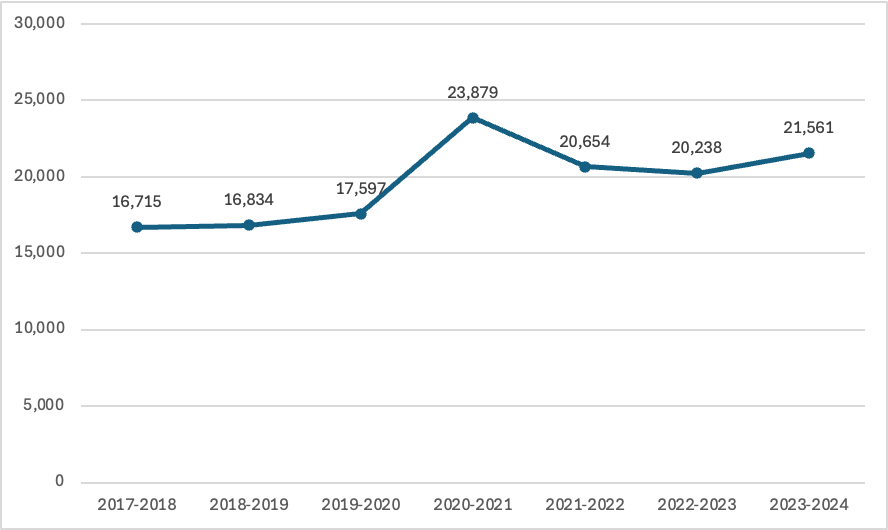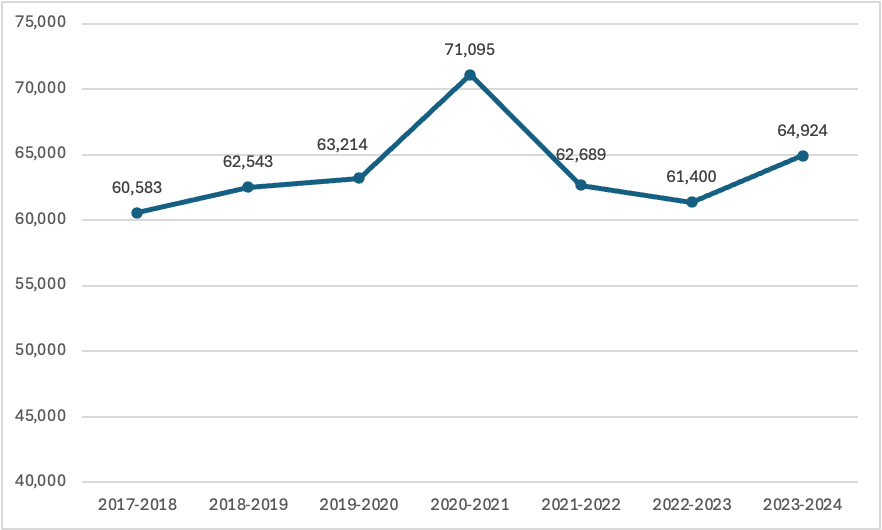The very first LSAC Volume Summary Report of the cycle just dropped, which means we have our first applicant (and application) data for 2024-2025.
Before we dive in, note that this kind of early data is most often volatile (small numbers = more potential for big swings), and this year it may be so more than ever. Additionally, we would suggest paying more attention to the applicant volume data (currently up 25.8%, but that number is coming way down, read on) than application volume. Remember that an applicant can apply to 160+ law schools (and a few have!), but said person can only matriculate to one law school. That translates to 159 applications that, eventually, become near-meaningless as said applicant is either denied by or turns down those many schools (they still have to fill up a class of applicants, not applications). So in this blog, we will focus on applicant volume, as those numbers will dictate the ultimate outcome of the cycle.
Finally, the LSAC Volume Summary page should auto-update every day, so if you want a data fix, there is plenty to be had.
Law School Applicant Volume Data
The upcoming application cycle is clearly up in applicants and applications, which very likely means a more competitive cycle. As of October 14, 2024, applicants are up 25.8% relative to this same time last year, and applications are up 37.8% (but remember, the latter number is far less important when thinking about overall cycle competitiveness). But those exact percentage figures are misleading, and probably extremely misleading. There is no way that we will end this cycle with applicants up 25.8%.
Why the Early Spike?
The early spike is, in part, due to the elimination of the Logic Games section. This had a dual effect of snagging all the people who were good at games and/or thought games to be the most learnable section, and front-load the LSAT in June. Then, the test-takers who didn’t want to take the games section were primed for the August test. And, boom goes the dynamite, we had tremendous increases in June and August LSAT-takers, and thus the early numbers are so predictably way up. We knew this was coming.
*But* the LSAT doesn’t create demand—people don’t say “There’s no Logic Games section on the LSAT anymore, so now I want to be a lawyer!”—it just shifts pace. So we will likely have a hyper front-loaded testing cycle, with early numbers that will be volatile and come down at a steady rate such that the early number of +25.8% will have significantly decreased by the end of the cycle.
Keep in mind, also, that last cycle was a particularly slow admissions cycle (widely regarded as the “slowest cycle ever”) due in part to the substantial application changes that happened nearly across the board last fall after the Supreme Court decision on race-conscious admissions. So while this year’s numbers are inflated because of a quicker pace, last year’s numbers are also deflated due to a slower pace.
How Will This Shake Out?
It’s a presidential election year, which almost always leads to more applicants, and there are additional societal reasons for more people to seek to become lawyers as well. But, the economy is looking more recession-proof than even a few months ago, which hedges against application spikes, especially if the entry-level job market follows the overall economy, which is at least likely to some extent (more and better entry-level jobs lead to fewer people going to graduate school, which is a very linear correlation). Of course, we are not economists, and even economists frequently disagree about predicting future conditions, so this is just our best assessment based on the information we have now.
By the end of the cycle, we anticipate an increase of +10% to +15%. The first applicant numbers we are seeing will be way higher than the overall cycle (looking at percentages relative to last cycle), which again will cool off. We expect to see a cycle that ends up with a more natural increase relative to the prior cycle, which is not uncommon for an election year. Nothing will stay up over 20% like it is now or higher like the early numbers might show. If I had to guess an exact number, I’d say +12% when all is said and done.
As far as competitiveness, more applicants means a more competitive cycle, I am sorry to have to say. Undergraduate GPAs will likely continue to go up, continuing the trend we have seen for years (often speculated to be the result of large-scale grade inflation), meaning law school median entering class GPAs will rise a bit. (Note: Final, official medians from the 2023-2024 cycle won't come out until ABA 509 disclosures are released, which typically happens in December, but you can find all of the LSAT/GPA medians that schools have unofficially announced in this spreadsheet.) LSAT score data is also not looking favorable for applicants at this point in the cycle—more on that below.
LSAT Score Data
Applicant volume isn't the only component of the competitiveness of an application cycle—the numerical strength of the applicant pool also matters a great deal. Here’s how the LSAT score bands for 2024-2025 are looking so far:
Law School Applicant Volume by LSAT Score – Last Cycle vs. This Cycle as of October 14, 2024
Currently, the LSAT score distribution looks daunting at the top, with scores 175-180 up 31%, scores 170-174 up 40%, and scores 165-169 up 36%. In theory, this relative distribution should normalize to some extent, but even if it does, more applicants mean more aggregate high numbers (hence the more competitive cycle), unless law schools increase their class sizes by ~12%, which they will not.
The historical context here is important. We saw a significant increase in the proportion of 160-180 LSAT Scores in the 2020-2021 cycle following the introduction of the LSAT-Flex, and while that proportion came down somewhat the following cycle, that decrease has not continued, as you can see below—the proportion of high LSAT scores remains extremely high.
Percentage of LSAT Applicants with 160-180 Scores Over Time

Total Number of LSAT Applicants with 160-180 Scores Over Time

Both the percentage of applicants and the total number of applicants with LSAT scores in the highest bands went up dramatically in the post-COVID cycles and never really normalized. Meanwhile, the proportion of those applying at the lowest end of the scoring scale is continuing to decrease.
Percentage of LSAT Applicants with <140-149 Scores Over Time

Total Number of LSAT Applicants with <140-149 Scores Over Time

That helps to explain why the past few application cycles haven't felt that much less competitive, even though they were marked declines in total applicant volume compared to 2020-2021 (see below).
Law School Applicant Volume Over Time, 2017-2018 through 2023-2024

We expected that the increase in top-scoring applicants would have normalized by now, but it hasn't. Will this trend continue in 2024-2025? It sure seems that way from the early data, and with higher overall applicant volume, that effect is compounded.
It's possible that part of the reason behind the continued increase in the highest LSAT score bands is that applicants have adjusted to the increase in competition by preparing for the LSAT more and taking the test more frequently. We've certainly seen an increase in the proportion of retakers. If that continues, then this may just be the new normal, and the LSAT bar could be higher for applicants going forward.
These current, early-cycle numbers may also be influenced by the removal of the LSAT Logic Games section, as we discussed earlier. The highest-performing LSAT-takers have long seen Logic Games as the most learnable section, with many 170+ scorers consistently getting perfect scores, so it seems plausible that a surge of these high LSAT scorers rushed to get their tests done by June while they otherwise would have waited for later test administrations and submitted their applications later as a result.
One Final Note
I briefly mentioned the notion of law schools increasing class sizes above, but to get more specific, I think we’ll likely see a 5% class size increase or so for fall 2025. Law schools have to fill seats to stay funded, and the more seats they fill, the more funded they are. So if we see a 12% increase in applicants but a 5% increase in matriculants/class size, that’s essentially a 7% more competitive cycle (the exact math is a bit funkier, but it’s a close approximation). Not so bad. And while you can’t control the competitiveness or the pace of admissions, what you can control is your application strength, which matters more in a competitive cycle, and especially this cycle more than ever due to the de-emphasis by U.S. News on admissions numbers in the overall rankings.


.png)






